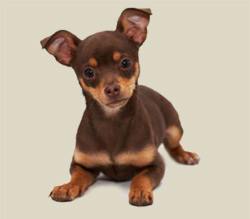
Country of Origin: Mexico
Group: Companion and Toy Dogs
Section: Chihuahuen o
Original Function: ceremonial
Todays Function: companion
Dimension Male: 15-23 cm
Dimension Female: 15-23 cm
Weight Male: 1-3 kg
Weight Female: 1-3 kg
Litter Size: 1-4 puppies, average 2
Life span: 14-18 years
Other Names: none
Colors: Any solid, marked, or splashed color.
Living: Chihuahuas are not outside dogs. they are at home in apartments, as well as in the country. due to t
Recognized: CKC, FCI, AKC, UKC, KCGB, CKC, ANKC, NKC, NZKC, APRI, ACR
Description
The Chihuahua is a tiny dog with an apple-shaped head and a short pointed muzzle. It has round, large, very dark eyes, sometimes dark ruby or luminous in color. The trademark large ears should be held erect. Puppies have a soft spot or "molera" on the top of the skull. The bone usually closes the gap by adulthood. The body is cobby (stout), longer than it is tall, and the tail is sickle-shaped - curled over the back or to the side. Besides the common short-haired variety there is also a long- haired type. Colors include fawn, sand, chestnut, silver and steel blue, but any color is accepted, including black & tan and parti-color. The dog is more robust than he looks, with a level back, and legs coming down straight and square.
Temperament
The saucy Chihuahua has earned its place as a favored toy dog because of its intense devotion to a single person. It is reserved with strangers but good with other household dogs and pets. Some try to be protective, but they are not very effective. Some may be quite bold; others may be timid. It is often temperamental. Some bark.
Excercise
The Chihuahua is a lively dog that nonetheless can get its exercise running from room to room indoors. It enjoys exploring the yard or going for short walks on a leash and especially enjoys accompanying its owner on outings. The Chihuahua is not an outdoor dog; it hates the cold and seeks out warmth. Coat care for the smooth is minimal. Care of the long coat entails brushing two to three times a week.
Grooming
The smooth, short-haired coat should be gently brushed occasionally or simply wiped over with a damp cloth. The long coat should be brushed daily with a soft bristle brush. Bathe both types about once per month, taking care not to get water in the ears. C
Health
Major concerns: none
Minor concerns: pulmonic stenosis, hydrocephalus, patellar luxation, KCS, hypoglycemia
Occasionally seen: none
Suggested tests: cardiac, knee
Note: A soft spot (molera) in the skull (due to incomple
Click here to ORDER this PUPPY
